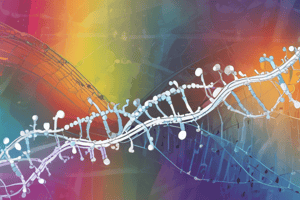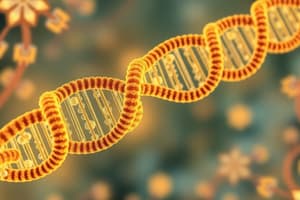Podcast
Questions and Answers
What is the first step in the transcription process?
What is the first step in the transcription process?
- Splicing of mRNA
- Unwinding of DNA (correct)
- Termination of transcription
- Addition of nucleotides
Which processes modify the mRNA before it leaves the nucleus?
Which processes modify the mRNA before it leaves the nucleus?
- Translation and termination
- Unwinding and elongation
- Splicing, editing, and polyadenylation (correct)
- Replication and transcription
What are the coding regions of mRNA called?
What are the coding regions of mRNA called?
- Introns
- Exons (correct)
- Codons
- Nucleotides
What is the role of the polyadenylation process in mRNA?
What is the role of the polyadenylation process in mRNA?
What is the term for RNA ready to transport information for protein synthesis?
What is the term for RNA ready to transport information for protein synthesis?
What occurs during the translation process?
What occurs during the translation process?
How does mRNA exit the nucleus to reach the ribosomes?
How does mRNA exit the nucleus to reach the ribosomes?
What is the primary function of transfer RNA (tRNA) in protein synthesis?
What is the primary function of transfer RNA (tRNA) in protein synthesis?
What is the primary role of DNA in protein synthesis?
What is the primary role of DNA in protein synthesis?
During which process is the genetic information transcribed from DNA to RNA?
During which process is the genetic information transcribed from DNA to RNA?
Where does transcription occur within a cell?
Where does transcription occur within a cell?
Which step of transcription involves the binding of RNA polymerase to the promoter?
Which step of transcription involves the binding of RNA polymerase to the promoter?
What is the messenger that transmits genetic information from DNA to ribosomes?
What is the messenger that transmits genetic information from DNA to ribosomes?
Which of the following correctly describes the translation process?
Which of the following correctly describes the translation process?
What determines the type of protein formed during protein synthesis?
What determines the type of protein formed during protein synthesis?
What occurs during the elongation phase of transcription?
What occurs during the elongation phase of transcription?
What is the role of transfer RNA (tRNA) during protein synthesis?
What is the role of transfer RNA (tRNA) during protein synthesis?
Which pairing is correct in the context of nucleotides between DNA, mRNA, and tRNA?
Which pairing is correct in the context of nucleotides between DNA, mRNA, and tRNA?
What is the function of codons in messenger RNA (mRNA)?
What is the function of codons in messenger RNA (mRNA)?
What does the term 'anticodon' refer to?
What does the term 'anticodon' refer to?
How many possible combinations of codons can be formed with four nitrogen bases?
How many possible combinations of codons can be formed with four nitrogen bases?
During the translation process, what happens after an amino acid is joined to the growing protein chain?
During the translation process, what happens after an amino acid is joined to the growing protein chain?
What is the significance of the start and stop codons in mRNA?
What is the significance of the start and stop codons in mRNA?
Which of the following correctly explains the process of transcription?
Which of the following correctly explains the process of transcription?
Flashcards are hidden until you start studying
Study Notes
Transcription
- The enzyme RNA polymerase binds to a region of a gene called the promoter, causing DNA to unwind
- DNA is "read" by the enzyme and a complementary strand of mRNA is formed
- Elongation is the addition of nucleotides to the mRNA strand
- Termination is the ending of transcription. The mRNA strand is complete and detaches from DNA.
- In eukaryotes, mRNA needs further processing before leaving the nucleus. This includes splicing, editing, and polyadenylation
- Splicing removes introns, regions of mRNA that do not code for proteins
- Remaining mRNA, called exons, code for proteins
- Polyadenylation adds a "tail" to the mRNA composed of adenine bases
- The tail signals the end of the mRNA, protects it from enzymes breaking it down, and aids in exporting it from the nucleus
- The codons are groups of three nucleotides that act as messengers in protein formation.
Translation
- Messenger RNA (mRNA) leaves the nucleus and attaches to a ribosome
- Transfer RNA (tRNA) is another type of RNA found in the cytoplasm
- Translation is the process where codons and anticodons form proteins
- Anticodons, short strands of tRNA, complement the codons in mRNA
- tRNA attaches to specific amino acids in the cytoplasm and lines up along mRNA, ensuring complementary base pairing
- The amino acids connect to eventually form a protein
- tRNA disconnects from the amino acid and mRNA to return to the cytoplasm and bind to another amino acid
DNA and Protein Synthesis
- Genes are segments of DNA that code for a specific protein for a particular trait
- DNA is responsible for protein synthesis
- There are 20 different amino acids
- The order of amino acids determines the type of protein
- Ribonucleic acid (RNA) acts as a messenger between DNA in the nucleus and ribosomes in the cytoplasm, where proteins are synthesised
- The process of transferring genetic information is called gene expression
- Transcription is the process of transcribing genetic information from DNA to RNA
- Translation is the process of translating genetic information from RNA to a protein
- The genetic code is based on nitrogen bases arranged in series of threes, called codons
- Each codon corresponds to a specific amino acid
- Triplet codes can create 64 different combinations of amino acids
- Some codons signal the start or end of protein chains
Example of DNA Codon Sequence
- DNA codon sequence: ACA – TGG – CGT
- mRNA codon sequence: UGU – ACC – GCA
- tRNA codon sequence: ACA – UGG – CGU
- Amino acids formed: Cysteine – Threonine – Alanine
Studying That Suits You
Use AI to generate personalized quizzes and flashcards to suit your learning preferences.




